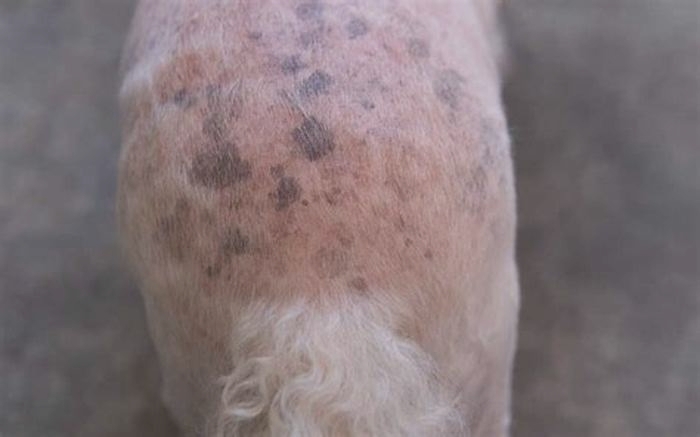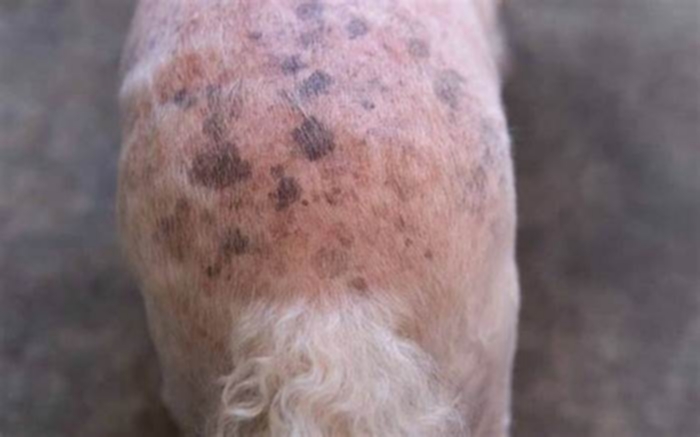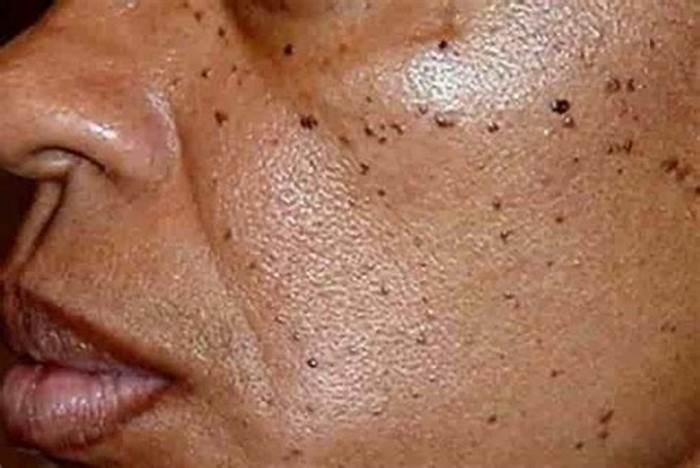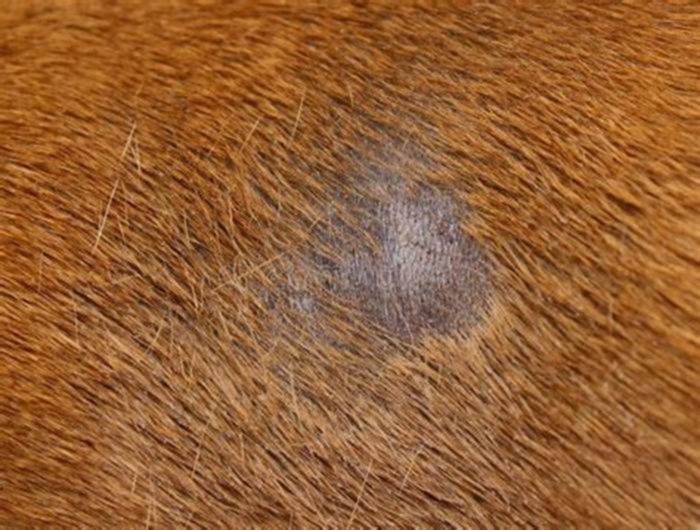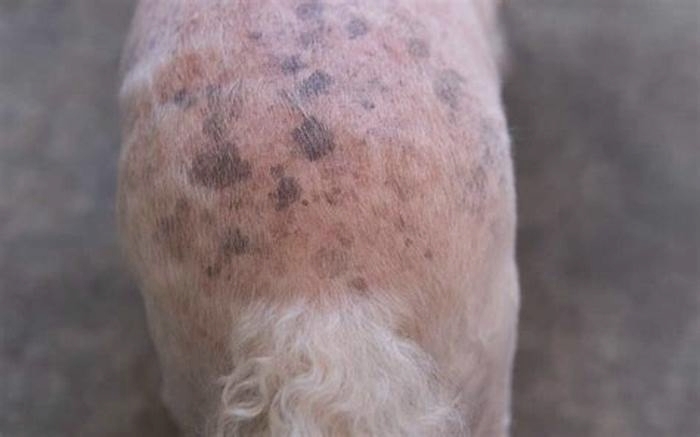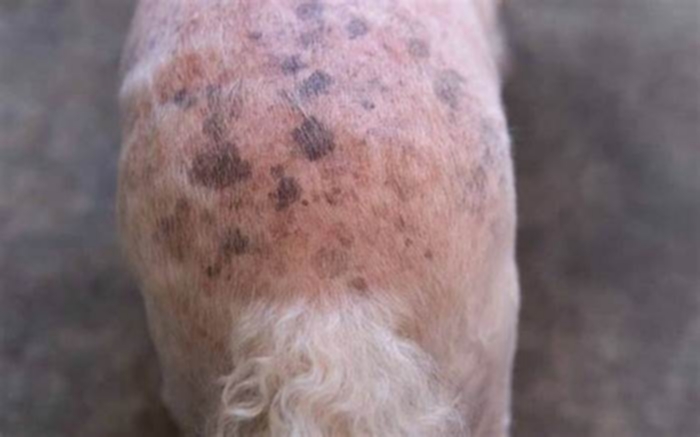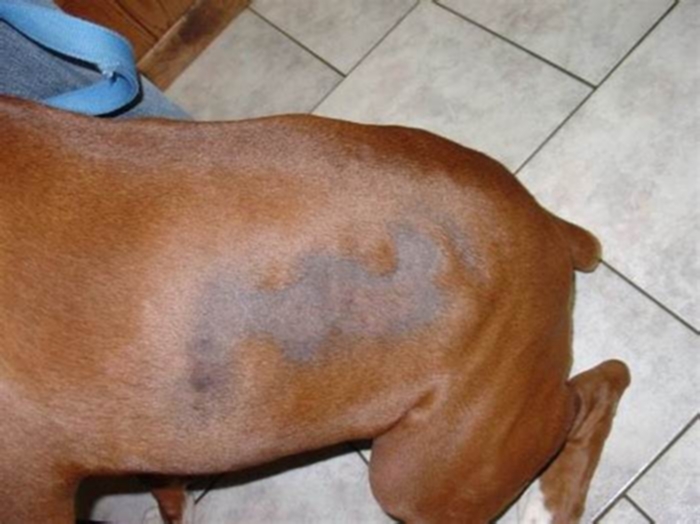What are black fungus spots on dogs skin
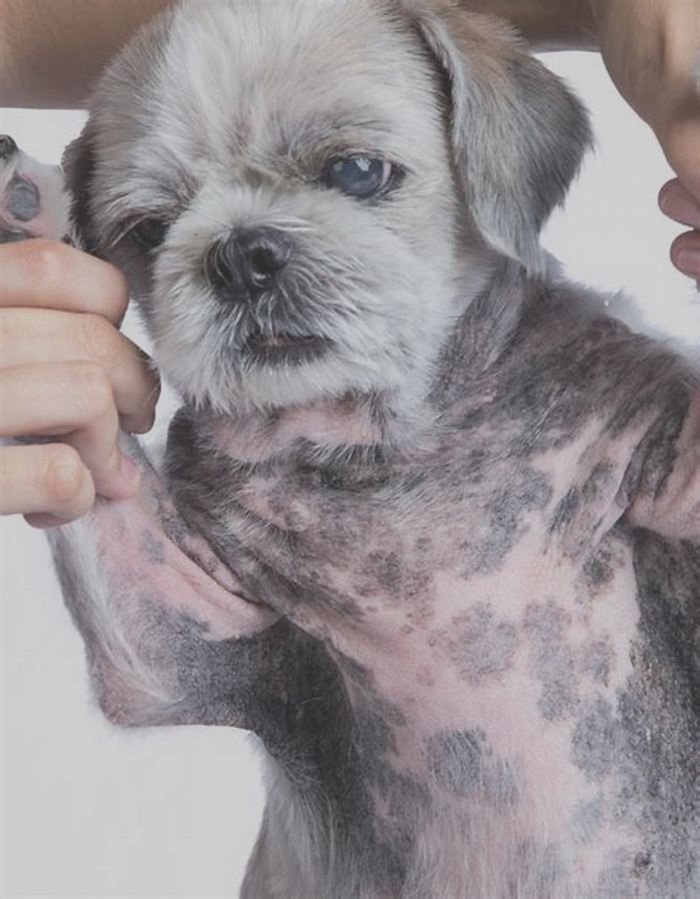
Black Spots on Dogs Skin: Causes, Diagnosis & Treatments
704
Seeing black spots on dogs skin can be frightening for dog owners. If your dog has black spots on its skin, this is the right article for you!
In cases like this, its necessary to identify probable causes in order to know what steps you should take.
For starters, black spots on dogs skin can be caused by several factors, and it may not be entirely alarming.
Although it can sometimes mean serious underlying diseases, it can also be just a harmless skin discoloration.
From causes to treatment and prevention, this guide covers everything you need to know about black spots on dogs skin. If you want to get more informed regarding this matter, read until the end!
What Are Black Spots on Dogs Skin?

Black spots on dogs skin may appear like patches of skin discoloration or even small, irregular-shaped lumps. Black spots are typically harmless on their own. However, these spots can also be accompanied by other symptoms, which may be indications of diseases that need medical attention.
Normally, black spots are a sign of hyperpigmentation in dogs. These are patches of rough, velvety, and thickened skin that is darker than the actual skin color.
Black spots usually appear on the dogs belly, groin area, and hind legs. Its mostly easier to spot in hairless dogs or breeds with white coats.
Hyperpigmentation, which may cause black spots in dogs, has two types, and these are:
- Primary Hyperpigmentation: Its considered primary hyperpigmentation if this is the only change in your dogs skin. Like freckles on humans, this is a rather common and harmless condition. Theres no reason behind its occurrence, and its just a result of physiological changes that affect the skin color of dogs, such as Dachshunds.
- Secondary Hyperpigmentation: Secondary hyperpigmentation in dogs is usually partnered with other skin lesions, such as hair loss, itchiness, swelling, redness, flaky skin, or bumps. This is a sign of a more serious condition and demands medical treatment.
Its important to note that dogs hyperpigmentation isnt a specific disease in itself but merely a reaction to other dog skin conditions.
Apart from hyperpigmentation in dogs, black spots may also appear as small and numerous dark bumps or as a localized lump surrounded by normal skin, which is rarer and more difficult to treat.
Causes of Black Spots on Dogs Skin
The causes of this hyperpigmentation vary greatly and depend on what they look like and what symptoms they accompany. Sometimes, it can be a result of skin trauma caused by scratching or injury.
When the affected area undergoes skin repair, there will be an increased production of melanin to protect the superficial skin layers.
Skin cells producing more melanin than normal will result in skin darkening.
To confirm the cause of these spots, you must bring your dog to the veterinary clinic, where they perform diagnostic tests like skin scrapings and impression smears.
Heres a list that shows the causes of black spots on dogs skin in relation to secondary hyperpigmentation in dogs:
- Skin Allergies: There are several allergens that may affect your dog, including food, plants, and insects. Intense itching from allergic reactions leads to scratching, licking, and rubbing. This will result in sores that will eventually turn to black spots, and worse, it may even result in atopic dermatitis or contact dermatitis.
- Skin Infections: These are often secondary to allergies or open wounds. Secondary bacterial infections make the skin irritated and cause chronic trauma, leading to dark spots in dogs.
- Skin Parasites: Fleas, ticks, lice, and mites are dog parasites that cause itching on the skin or mange. This leads to scratching and therefore results in dark patches.
- Hypothyroidism: Hypothyroidism is a common endocrine disorder in dogs that is caused by inflammation or shrinkage of the thyroid gland, resulting in a decreased production of thyroid hormones. Symptoms of this include lethargy, unexplained weight gain, and haircoat and dog skin changes.
- Cushings Disease: Cushings disease is another endocrine disorder wherein the adrenal glands produce excessive hormones called cortisol. Symptoms of this include increased thirst and appetite, panting, lethargy, hair loss, skin infections, and dark patches.
The last two are diseases that cause hormonal imbalances in dogs. Thats because skin problems are usual indicators of hormonal issues in pets.
These commonly affect breeds like Golden Retrievers and Labradors.
Meanwhile, the list below shows the causes of black spots on dogs skin in relation to small lumps:
- Comedones: Schnauzer comedo syndrome is small, black, pimple-like bumps exclusively affecting Miniature Schnauzers. They are often accompanied by localized hair loss near the area where the bumps are, typically on the neck and along the back. Though these blackheads are harmless, they are itchy and need to be treated.
- Tumors: A black spot on your dogs skin that seems like a lump can be caused by a skin tumor, such as melanoma or epidermal hamartoma. Melanoma may either be benign or malignant and can grow anywhere on the outer part of the body. On the other hand, epidermal hamartomas are benign tumors mostly affecting pups.
There are also cases where the black spots on your dogs skin appear like black pepper flakes scattered on its fur.
It may seem like a material on the dogs coat that comes off or moves when you brush through it.
This is flea dirt or dried blood dropping caused by fleas. These black spots can be washed off. However, it also means that theres the presence of fleas on your dog.
Can Black Spots on Dogs Skin Be a Sign of Cancer?
A black spot on a dogs skin can be an indication of skin cancer called dermal malignant melanoma.
The black spots associated with this condition appear like dark pigmentation and raised mass on dogs skin, particularly on parts where the hair is thin. These parts include the face, areas around the genitals, and the dogs belly.
Causes of this involve genetics, too much sun exposure, chemical exposure, and hormonal abnormalities.
Dermal malignant melanoma has the potential to grow and metastasize in other parts of the body.
That said, its recommended to immediately call your vet if you notice any bumps on your dogs body that resembles a melanoma.
Black Spots on Dogs Skin Look Like Dirt

Apart from skin hyperpigmentation and dark lumps, there are also cases where the black spots on your dogs skin may look like dirt.
If your dog has this, it may be suffering from a fairly common yeast infection. Yeast infection is caused by an abnormal overgrowth of yeast in the dogs body.
Its a harmless fungus that normally lives in the body and is commonly found in places like the ear canal. When its overabundant, it causes illness.
This illness usually occurs when a dogs immune system is weakened. Often, yeast infection grows on the dogs belly, around the genitals, and the groin area. However, it can also be found on the ears, paws, and armpits.
Symptoms of yeast infection, which may cause black spots on dogs skin, include:
- Licking, rubbing and scratching on the affected areas
- Foul odor or cheese-like scent
- Lethargy and decreased appetite
- Hair loss
- Skin texture may become leathery, thick, or scaly
- Redness and swelling
- Seborrhea or greasy skin
- Speckles of tiny black spots that look like dirt
With these symptoms, its apparent that yeast infection causes discomfort to many dogs. Hence, its important to get them the treatment they need.
Check out this homemade dog food recipe that may help clear up black spots on your dog caused by yeast infection:
Black Spots On Dogs Skin With Hair Loss
Almost all black spots on the dogs skin accompany hair loss. Conditions like skin infections, endocrine disorders, blackheads, tumors, and yeast infections all cause hair loss.
However, the most common cause of black spots with hair loss is alopecia X. This appears as dark patches of baldness with crusty skin. This genetic condition is caused by a hormonal imbalance in dogs.
Alopecia X is generally harmless. Its only a cosmetic condition that doesnt cause itchiness or discomfort in dogs. It merely affects the way they look.
Still, a skin biopsy is important to help rule out some conditions with similar symptoms to alopecia X, such as Cushings disease and hypothyroidism.
How to Get Rid of Black Spots on Dogs Skin

Getting rid of black spots on dogs skin will vary depending on the underlying cause.
Its recommended to consult with your veterinarian to determine the diagnosis. They might need to perform tests, such as skin scrapings or impression smears, to rule out other causes.
When the cause of the underlying skin problem is identified, thats the best time to talk about the best treatment plan.
For example, primary hyperpigmentation and alopecia X dont require treatment. However, if the former is accompanied by skin inflammation, it may be cured by medicated shampoos and steroid ointments.
To treat secondary hyperpigmentation like skin allergies, infections, and endocrine disorders, experts need to treat underlying conditions first before treating the black spots.
This recommendation also applies to blackheads, tumors, fleas, and yeast infections.
Skin allergies can be treated by avoiding the allergen or through allergy relief medication prescribed to the affected dog.
Additionally, to treat a skin infection, oral antibiotics or topical spray and shampoo may be necessary.
Further, treatment of endocrine disorders would heavily depend on veterinary medicine and guidance.
When it comes to treating the conditions causing black spots forming lumps, topical ointments or shampoo are good for comedones, and surgical removal is recommended for tumors, whether they are malignant or benign.
Fleas, on the other hand, can be controlled with spray-on flea medication or topical ointments. Meanwhile, yeast infections can be treated with antifungal medications or a specialized diet.
As soon as the underlying disease is treated, the black spots will resolve on their own. However, note that it will take a long time for the pigmented skin to lighten up or go back to its normal color.
How to Prevent Hyperpigmentation & Black Spots in Dogs
Because there are many varying causes of black spots on dogs skin, it can be quite difficult to know exactly how to prevent them.
But, there are general ways that may lessen the instance of your dog acquiring it.
To help you out, listed below are tips to prevent hyperpigmentation and black spots in dogs:
- Keep your dogs skin and coat clean
- Bathe and brush your dog regularly
- Wash all wounds and itchy areas with warm water and mild soap
- Limit outdoor activities, especially during warm and humid days
- Watch your dogs diet and avoid possible allergens that may affect your dog
- Visit your vet regularly
By following these tips, dogs will also have a lesser chance of acquiring genetic conditions and breed-specific issues in relation to black spots.
Furthermore, its advised to do regular checkups for early diagnosis and to keep these health issues from worsening.
Also, consider investing in pet insurance to greatly reduce your poochs medical costs in the long run.
Frequently Asked Questions

Why Is My Dog Getting Black Spots On Her Belly?
There are several reasons why your dog is getting black spots on the belly. Primary hyperpigmentation is one cause. Its a harmless skin condition only affecting the Dachshund breed.
Other causes of black spots on your dogs belly are yeast infections and melanoma. If youre concerned about your dog possibly having these health issues, its best to consult with your vet.
Why Is My Dog Getting Black Spots On Her Chest?
Black spots on your dogs chest may also mean primary hyperpigmentation or an underlying cause thats more serious and requires medical treatment.
These causes can be any of the conditions mentioned in this guide, such as skin allergies and secondary infections, hormonal disorders, fleas, yeast infections, or alopecia X.
Does Dog Yeast Infection Cause Black Spots on a Dogs Skin?
Yeast infection can cause black spots on dogs skin. It generally doesnt appear as hyperpigmentation, but its typically described as black spots that look like dirt.
Final Thoughts
Black spots on dogs skin can mean a lot of things. Although generally, they are just a reaction to an underlying condition.
Black spots are sometimes harmless, but they can also mean serious conditions, especially if accompanied by other symptoms.
In relation to your dogs health, its not advised to come up with a self-diagnosis. Its still better to consult with your veterinarian to identify what really causes the black spots and what are the possible treatments.
For the dogs safety, its also important to note that any oral and topical treatments that you ought to give them should be prescribed by your veterinarian.
Hopefully, you learned a lot about your dogs skin condition in this guide. If you have any experience related to black spots on dogs skin, let us know in the comment section below!

